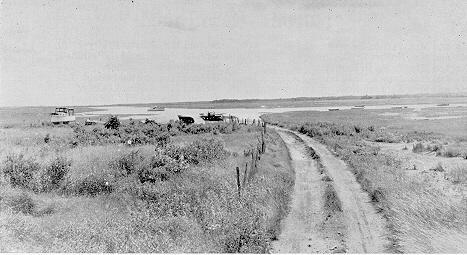Old Home Day
1638 - Town of Hampton - 1962

October 1638 - August 1962
Of all the historical places and locations of Hampton, one should first visit and view The Hampton Landing, scene of the first appearance of our first pioneer families led by Rev. Stephen Bachiler.
It was on the 14th day of October in the year 1638 that a small group of "God Fearing" Puritans from Newbury, rowed "UP" Hampton River to the Lower Landing. Here, led by Rev. Bachiler, this small group made its way along an Indian trail to what is known as the Tuck Memorial Green.
Here the househeads laid out 40 acres of land, previously cleared by the Indians, for their homes, fields, and farms. From this October day to the present, the Landing has played a major part in the history of Hampton. In 1640 and again each year thereafter, more families came to the Hampton settlement until by 1680 the population had grown to 707 men, women and children. Almost all of these settlers first saw Hampton from the Landing.
In the next new years of the young community, the landing became the destination of boats carrying lumber for the houses as well as food and supplies for Hampton. The first year, over 400 cows were brought up river to the rich marsh pasture lands. When the settlement became better established, the products of farm and sea were loaded at the Landing on ships bound for the Newburyport trade.
By 1682, the Landing had become the site of the first shipbuilding industries. Here men built the sturdy dory and barque. Here Samuel Nudd, Peter Garland, Caleb Shaw, Joshua Wingate, and others furnished local fishermen with the boats so necessary to the life and economy of Hampton.
In later times the Landing became the site of the first salt works, where David Nudd in 1827 established an industry that was to realize over 1,200 bushels of salt a year.
By 1850, the railroads had made river passage from the Landing to nearby Massachusetts towns unprofitable. Also, the fishing and boat-building industries of Hampton had given way to other businesses. The value of the Landing did not disappear, however, now the marshes gave way to farmers loading salt hay for feed for their animals and hunters searching the skies for the various game birds that found the marshes a haven for themselves and their young. The canals and rivers flowing through this area saw the arrival of family pleasure-boating groups. The Landing then became the center of these activities.
Today one has only to stroll down Landing Road to Nudd's Landing and the nearby Hampton Boat Club to see how the Landing is still very much a part of modern day Hampton.
